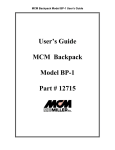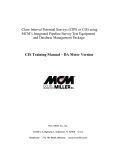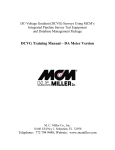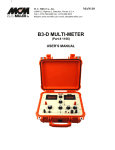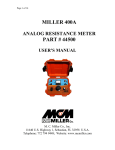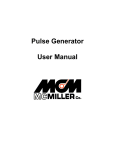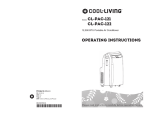Download DCVG-CIS Switch Box Manual
Transcript
MAN250 DCVG/CIS Switch Box Controller (Catalog # 12555) Manual Revised August 16, 2011 M. C. Miller Co., Inc. 11640 U.S. Highway 1, Sebastian, FL 32958 Telephone: 772 794 9448; Website: www.mcmiller.com CONTENTS Page SECTION 1: INTRODUCTION …………………………………….. 3 SECTION 2: HOW TO USE THE SWITCH BOX WITH THE DA METER 2. 1 2. 2 How to Set Up Combined Surveys ……………………………. How to Hook-Up the Test Equipment for Combined DCVG/CIS Surveys ………………………………………... 4 6 SECTION 3: HOW TO USE THE SWITCH BOX WITH THE G1 DATA-LOGGER 3. 1 3. 2 How to Set Up Combined Surveys ……………………………… 8 How to Hook-Up the Test Equipment for Combined DCVG/CIS Surveys ………………………………………… 11 SECTION 4: HOW TO USE THE SWITCH BOX WITH THE Gx DATA-LOGGER 4. 1 4. 2 How to Set Up Combined Surveys ……………………………… 13 How to Hook-Up the Test Equipment for Combined DCVG/CIS Surveys ………………………………………… 17 2 SECTION 1 INTRODUCTION The MCM Switch Box makes it possible to collect both DCVG survey data and CIS data from a section of pipeline on a single pass in conjunction with the DA Meter, the G1 Data-logger, or, the Gx data-logger. In the combined survey mode, at each measurement location, the DCVG data are first recorded and then the Switch Box performs a switching operation that allows the CIS pipe-to-soil voltages to be recorded. When the CIS data have been recorded, the data-logger “beeps”, which is the signal that you can move the reference electrodes to the next measurement location. The data recording process is initiated using the push-button switch on the left-hand (red-handled) data-probe. Note: Several cycles worth of data need to be processed by the data-logger software in order to record DCVG data and CIS data at each measurement location: First, a stable DCVG voltage needs to be established following data-probe planting at a new location, which may require processing of several cycles of data since the data-probes will both have been off the ground prior to re-planting the probes. Second, representative On and Off potentials need to be established following the triggering event which may require processing several cycles of data since the CIS data will only be available to the voltmeter following the triggering event (i.e. following the switch from a cell-to-cell configuration to a pipe-to-cell configuration). A major difference between Combined DCVG/CIS applications and conventional DCVG and CIS applications is that, in the Combined DCVG/CIS case, only the push-button trigger on the left-hand cane (redhandled cane) is enabled (the push-button on the right-hand cane (greenhandled cane) is disabled). Consequently, the left-hand (red-handled) cane’s push-button switch is used to trigger the (DCVG and CIS) data recording process. And, since only one data-probe switch is enabled, survey flags, if used, will have to be designated by tapping on the “Flag” button on the Survey screen. 3 Prior to performing Combined DCVG/CIS applications, it is highly recommended that you first use the data-logger to perform individual DCVG and CIS surveys, in order to become familiar with the test apparatus (including the data-logger) and the measurement procedures for both survey types. You are also referred to our DCVG and CIS Training Manuals, which are companion manuals to your Data-logger User’s Manual, for specific instructions on how to perform these survey types. SECTION 2 HOW TO USE THE SWITCH BOX WITH THE DA METER 2.1 How to Set Up Combined Surveys: The set up procedures for Combined DCVG/CIS applications, as far as the DA Meter is concerned, are very similar to those detailed in the DCVG Training Manual – DA Meter Version. The first step is to select “DCVG/CIS” from the drop down menu in the “Survey Type” field shown on the above screen. 4 You will notice that you are not able to select the functionality for the leftand right-hand data-probes in this survey type, since, as discussed above, the push-button on the right-hand cane (green-handled cane) is disabled. You will initiate the recording of, first, the DCVG data and, second, the CIS data, by pressing the left-hand cane’s push-button at each measurement location down the length of the pipe. You can, however, select the functionality you desire for the left-hand cane’s push-button during “Device” measurements, i.e. measurements at datacollection points (D.C.P.’s). As before, you can select “None” which will mean that pressing the push-button at Devices will do nothing, you can select “Accept”, which means that the data at D.C.P.’s will be accepted when you press the push-button and you would then tap on the “save” button on the “Device” screen to save the data, or you can select “Save”, which means that the data at D.C.P.’s will be saved when you press the pushbutton. Alternatively, you can tap on the “Save” button on a Device screen to save the readings data. You should then proceed through the various set up screens, making your selections as before. Once you have gone through the set up screens, the Survey screen will appear as shown below. As can be seen from the above screen, the Combined DCVG/CIS Survey screen looks very similar to the DCVG survey screen. 5 The major difference, however, is the presence of the “CIS” button. You can, at anytime during the Combined Survey, tap on the “CIS” button to view the CIS data that have been recorded. The data will be displayed on the graph. After viewing the CIS graph, you can return to the above screen by tapping on the “DCVG” button which will have replaced the “CIS button”. As mentioned in the Introduction, DCVG and CIS data can be collected at each measurement location by virtue of using the MCM Switch Box. When you select the “DCVG/CIS” Survey Type, the DA Meter will enable the “DCVG/CIS Switch” option. You can check to make sure that this Switch option has been enabled by tapping on “Survey Options” and then tapping on “Settings” which will pull up the screen shown below. The tick beside the “Use DCVG/CIS Switch” option indicates that this option has been enabled. 2. 2 How to Hook-Up the Test Equipment for Combined DCVG/CIS Surveys The cable connections for Combined DCVG/CIS applications employing MCM test equipment are illustrated below in Figure 1. 6 Figure 1: Cable Connections for Hook-Up of MCM’s Combined DCVG/CIS Survey Test Equipment As can be seen from Figure 1, a pair of canes (reference electrodes) is illustrated, the left-hand cane (RED-handled cane) and the right-hand cane (GREEN-handled cane). The canes are placed on the soil in the “Perpendicular” configuration, typically (see DCVG Training Manual - DA Meter Version). As discussed in the Introduction, only the push-button on the left-hand cane (red-handled cane) is enabled for Combined DCVG/CIS applications. This cane is positioned directly over the pipe and it is connected to the MCM Switch Box via the “black-band” cable. The “black-band” cable is connected to the Switch Box at the 5-pin terminal labeled as “CIS”. The right-hand cane (green-handled cane) is connected to the Switch Box via the “red-band” cable and this cable is connected to the Switch box at the 5-pin terminal labeled as “DCVG”. 7 The cable connecting the DA Meter to the Switch Box is connected to the 5pin terminal labeled, “Meter”, on the Switch Box. Finally, the banana plug cable connecting the Hip-Pack (Trail Wire) to the Switch Box is connected to the banana plug terminal labeled, “Structure” on the Switch Box. GPS receiver units, if employed, would be connected to the data-logger via the 9-pin serial data connection terminal on the top-side of the DA Meter (COM 1 Port). With a GPS unit, the location of items such as flags, devices, geo-features and anomalies can be recorded during the performance of combined surveys, either manually by tapping on the “Log GPS” button on the survey screen at each critical location or automatically by preprogramming the data-logger as described in the data-logger User’s Manual. SECTION 3 HOW TO USE THE SWITCH BOX WITH THE G1 DATA-LOGGER 3.1 How to Set Up Combined Surveys The set up procedures for Combined DCVG/CIS applications are very similar to those detailed for DCVG surveys in the DCVG Training Manual – G1 Version. 8 The first step is to select “DCVG/CIS” from the drop down menu in the “Survey Type” field shown on the above screen. You will notice that you are not able to select the functionality for the leftand right-hand data-probes in this survey type, since, as discussed above, the push-button on the right-hand cane (green-handled cane) is disabled. You will initiate the recording of, first, the DCVG data and, second, the CIS data, by pressing the left-hand cane’s push-button at each measurement location down the length of the pipe. You can, however, select the functionality you desire for the left-hand cane’s push-button during “Device” measurements, i.e. measurements at datacollection points (D.C.P.’s). As before, you can select “None” which will mean that pressing the push-button at Devices will do nothing, or you can select “Save”, which means that the data at D.C.P.’s will be saved when you press the push-button. Alternatively, you can tap on the “Save” button on a Device screen to save the readings data. 9 You should then proceed through the various set up screens, making your selections as before. Since this is a Combined DCVG and CIS application, you will only have two choices regarding Voltmeter Read Mode (since the DCVG part requires current-interruption and measurable differences between ON and OFF pipe-to-soil voltages (i.e., measurable IR drops, which rules out the Min/Max mode). The two options are On/Off Pairs (DSP mode) and On/Off Pairs (GPS Sync. mode). The GPS Sync. reading mode can only be selected if you are using the MCM Internal GPS receiver and you are also using current-interrupters with integrated GPS receivers. Once you have gone through the set up screens, the Survey screen will appear as shown below. As can be seen from the above screen, the Combined DCVG/CIS Survey screen looks very similar to the DCVG survey screen. The major difference, however, is the presence of the “CIS” button. You can, at anytime during the Combined Survey, tap on the “CIS” button to view the CIS data that has been recorded. The data will be displayed on the graph. 10 After viewing the CIS graph, you can return to the above screen by tapping on the “DCVG” button which will have replaced the “CIS button”. As mentioned in the Introduction, DCVG and CIS data can be collected at each measurement location by virtue of using the MCM Switch Box. When you select the “DCVG/CIS” Survey Type, the G1 will enable the “DCVG/CIS Switch” option. You can check to make sure that this Switch option has been enabled by tapping on “Options” and then tapping on “Settings” which will pull up the screen shown below. The tick beside the “Use DCVG/CIS Switch” option indicates that this option has been enabled. 3. 2 How to Hook-Up the Test Equipment for Combined DCVG/CIS Surveys The cable connections for Combined DCVG/CIS applications employing MCM test equipment are illustrated below in Figure 2. 11 Figure 2: Cable Connections for Hook-Up of MCM’s Combined DCVG/CIS Survey Test Equipment As can be seen from Figure 2, a pair of canes (reference electrodes) is illustrated, the left-hand cane (RED-handled cane) and the right-hand cane (GREEN-handled cane). The canes are placed on the soil in the “Perpendicular” configuration (see DCVG Training Manual-G1 Version). As discussed in the Introduction, only the push-button on the left-hand cane (red-handled cane) is enabled for Combined DCVG/CIS applications. This cane is positioned directly over the pipe and it is connected to the MCM Switch Box via the “black-band” cable. The “black-band” cable is connected to the Switch Box at the 5-pin terminal labeled as “CIS”. 12 The right-hand cane (green-handled cane) is connected to the Switch Box via the “red-band” cable and this cable is connected to the Switch box at the 5-pin terminal labeled as “DCVG”. The cable connecting the G1 data-logger to the Switch Box is connected to the 5-pin terminal labeled, “Meter”, on the Switch Box. Finally, the banana plug cable connecting the Hip-Pack (Trail Wire) to the Switch Box is connected to the banana plug terminal labeled, “Structure” on the Switch Box. The GPS Antenna illustrated on the top side of the G1 in Figure 2 represents the antenna employed by the data-logger’s internal GPS receiver. External GPS receiver units, if employed, would be connected to the data-logger via one of the two COM Port terminals located on the bottom side of the G1. (The right-hand-side COM Port (COM 4) is recommended). With either the internal unit or an external GPS unit, the location of items such as flags, devices, geo-features and anomalies can be recorded during the performance of combined surveys, either manually by tapping on the “Log GPS” button on the survey screen at each critical location or automatically by preprogramming the data-logger (as described in the data-logger User’s Manual). SECTION 4 HOW TO USE THE SWITCH BOX WITH THE Gx DATA-LOGGER 4.1 How to Set Up Combined Surveys The set up procedures for Combined DCVG/CIS applications are very similar to those detailed for DCVG surveys in the DCVG Training Manual – Gx Data-logger Version. 13 The first step is to select “DCVG/CIS” from the drop down menu in the “Survey Type” field shown on the above screen. You will notice that you are not able to select the functionality for the leftand right-hand data-probes for this survey type, since, as discussed above, the push-button on the right-hand cane (green-handled cane) is disabled. You will initiate the recording of, first, the DCVG data and, second, the CIS data, by pressing the left-hand cane’s push-button at each measurement location down the length of the pipe. You can, however, select the functionality you desire for the left-hand cane’s push-button during “Device” measurements, i.e. measurements at datacollection points (D.C.P.’s). As before, you can select “None” which will mean that pressing the push-button at Devices will do nothing, or you can select “Save”, which means that the data at D.C.P.’s will be saved when you press the push-button. Alternatively, you can tap on the “Save” button on a “Device” screen in order to save device readings. 14 You should then proceed through the various set up screens, making your selections as before. Since this is a Combined DCVG and CIS application, you will only have two choices regarding Voltmeter Read Mode (since the DCVG part requires current-interruption and measurable differences between ON and OFF pipe-to-soil voltages (i.e., measurable IR drops, which rules out the Min/Max mode). The two options are On/Off Pairs (DSP mode) and On/Off Pairs (GPS Sync. mode). The GPS Sync. reading mode can only be selected if you are using the MCM Internal GPS receiver and you are also using current-interrupters with integrated GPS receivers. Once you have gone through the set up screens, the Survey screen will appear as shown below. As can be seen from the above screen, the Combined DCVG/CIS Survey screen looks very similar to the DCVG survey screen. 15 The major difference, however, is the presence of the “CIS” button. You can, at anytime during the Combined Survey, tap on the “CIS” button to view the CIS data that have been recorded. The data will be displayed on the graph. After viewing the CIS graph, you can return to the above screen by tapping on the “DCVG” button which will have replaced the “CIS button”. As mentioned in the Introduction, DCVG and CIS data can be collected at each measurement location by virtue of using the MCM Switch Box. When you select the “DCVG/CIS” Survey Type, the Gx will enable the “DCVG/CIS Switch” option. You can check to make sure that this Switch option has been enabled by tapping on “Options” and then tapping on “Settings” which will pull up the screen shown below. The tick beside the “Use DCVG/CIS Switch” option indicates that this option has been enabled. 16 4. 2 How to Hook-Up the Test Equipment for Combined DCVG/CIS Surveys The cable connections for Combined DCVG/CIS applications employing MCM test equipment are illustrated below in Figure 2. Figure 2: Cable Connections for Hook-Up of MCM’s Combined DCVG/CIS Survey Test Equipment As can be seen from Figure 2, a pair of canes (reference electrodes) is illustrated, the left-hand cane (RED-handled cane) and the right-hand cane (GREEN-handled cane). The canes are placed on the soil typically in the “Perpendicular” configuration (see DCVG Training Manual-Gx Version). 17 As discussed in the Introduction, only the push-button on the left-hand cane (red-handled cane) is enabled for Combined DCVG/CIS applications. This cane is positioned directly over the pipe and it is connected to the MCM Switch Box via the “black-band” cable. The “black-band” cable is connected to the Switch Box at the 5-pin terminal labeled as “CIS”. The right-hand cane (green-handled cane) is connected to the Switch Box via the “red-band” cable and this cable is connected to the Switch box at the 5-pin terminal labeled as “DCVG”. The cable connecting the Gx data-logger to the Switch Box is connected to the 5-pin terminal labeled, “Meter”, on the Switch Box. Finally, the banana plug cable connecting the Hip-Pack (Trail Wire) to the Switch Box is connected to the banana plug terminal labeled, “Structure” on the Switch Box. The GPS Antenna illustrated on the top side of the Gx in Figure 2 represents the antenna employed by the data-logger’s internal GPS receiver. External GPS receiver units, if employed, would be connected to the data-logger via the serial port located on the bottom side of the Gx. With either the internal unit or an external GPS unit, the location of items such as flags, devices, geo-features and anomalies can be recorded during the performance of combined surveys, either manually by tapping on the “Log GPS” button on the survey screen at each critical location or automatically by preprogramming the data-logger (as described in the data-logger User’s Manual). Revised August 16, 2011 18


















